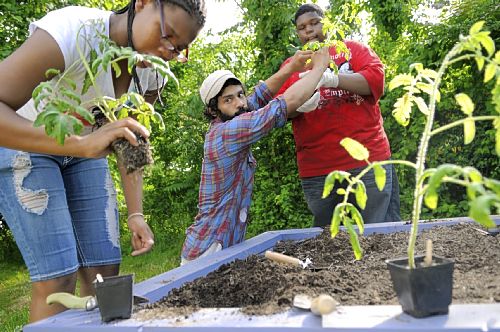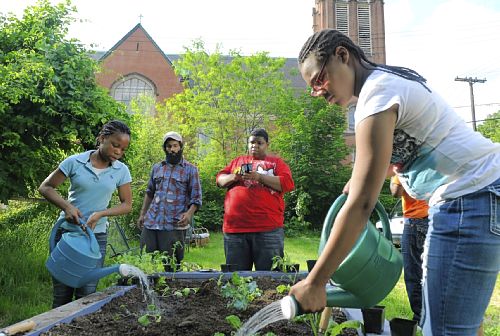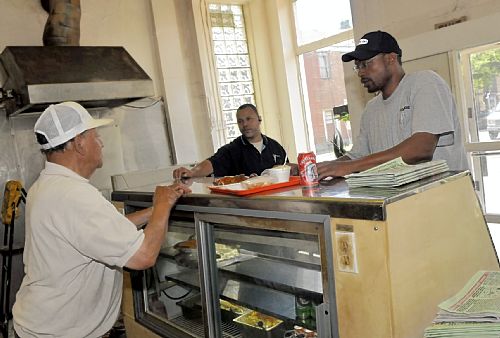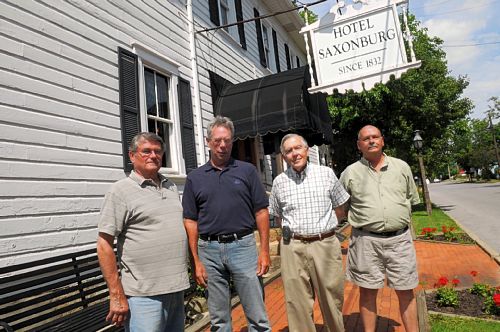
Category Archive: News Wire Services
-
County Bridges All Gaps But One in Pittsburgh-to-D.C. Trail: Onorato Wants it Completed by 2011
Thursday, July 08, 2010By Jon Schmitz, Pittsburgh Post-Gazette
The 62-ton bridge across railroad tracks is lifted into place in Whitaker on Wednesday. Darrell Sapp/Post-Gazette
Construction cranes on Wednesday eliminated two of the biggest obstacles to completing a 335-mile biking and hiking trail from Pittsburgh to Washington, D.C., a project that has been in the works for 35 years.Crews hoisted prefabricated bridges over active freight rail lines in Whitaker and Duquesne along the Monongahela River. Construction of a 21/2-mile trail segment linking the bridges to the existing trail will begin by fall, with completion expected by January, said Jack Paulik, project manager for Regional Trail Corp.
“This is a major milestone,” Mr. Paulik said.
All that will remain incomplete on the Great Allegheny Passage after that is a one-mile stretch through Sandcastle Waterpark. Negotiations with the park owners have not produced an agreement that will allow the trail to go through.
“There’s no solution just yet,” Allegheny County spokesman Kevin Evanto said. “We’re kind of at the same place we were a couple months ago.”
County Executive Dan Onorato has established a goal of completing the trail by “11-11-11” — Nov. 11, 2011. Mr. Evanto said the goal is reachable.
A 170-foot-long, 62-ton bridge erected in Whitaker crosses six sets of tracks operated by Norfolk Southern Railway and Union Railroad Co. A 110-foot-long, 37-ton bridge in the RIDC industrial park in Duquesne crosses three sets of Norfolk Southern tracks.

The 62-ton bridge across railroad tracks is lifted into place in Whitaker on Wednesday. Darrell Sapp/Post-Gazette
The bridges will provide “a spectacular view of the river, the working river,” Mr. Paulik said.
Pushing the trail through the former industrial sites and over the rail lines ranks near the top of the development feats on the trail project, he said, along with renovation of the 3,291-foot Big Savage Tunnel in Somerset County that was completed in 2006.
The two bridges erected on Wednesday are about 2 miles apart and will be connected with a trail along U.S. Steel’s former coke gas pipeline, which the company donated in 2007. The segment will hug the hillside between Route 837 and the river, connecting to McKeesport to the south and The Waterfront complex to the north.
A $500,000 state grant helped to fund the bridges, with private money paying the rest of the $950,000 cost, Mr. Paulik said. Developing the piers and substructure cost $2.5 million, nearly all of which was private donations, he said.
The bridges will enable trail users to avoid Route 837, which is dangerous for bicycling.
Development of the 150-mile Great Allegheny Passage, which connects at Cumberland, Md., with the C&O Towpath to Washington, began in 1975 with the abandonment of 87 miles of railroad line from Cumberland to Connellsville.
Nine years later, the first 9.5 miles of trail opened in Ohiopyle State Park.
-
Cities, Including Pittsburgh, Are Turning Green With Urban Farms
Thursday, July 08, 2010By Diana Nelson Jones, Pittsburgh Post-GazetteThe urban farm — a novel, even whimsical, idea a few years ago in Pittsburgh — is now a movement so fully fledged that a neighborhood without one seems almost an anomaly.
Nationally, the movement is profuse, with seeds in the 1980s when foodies sprouted and gourmet eating went mainstream. The roots of several movements have intertwined since: urban enterprise farms, urban farms for educating children, community gardens, vacant lot greening, soil remediation of industrial landscapes, community supported agriculture, backyard chickens and bee hives, consumers who buy into livestock with farmers and grocery chains selling local produce.
Grow Pittsburgh, whose mission is to support urban gardening, is a 5-year-old nonprofit that can’t keep tabs on the number of gardens being planted in the city’s public spaces, said Julie Butcher Pezzino, executive director.
Grow Pittsburgh is a partner of groups operating gardens in Braddock, Lawrenceville, Larimer and Lemington. It is searching for a suitable plot Uptown and has Troy Hill and Hazelwood on schedule for next year.
An online search of terms such as “urban farm,” “sustainable food” and “buy local” shows how robust the movement is in other cities. Interest here has skyrocketed.
Grow Pittsburgh’s latest foray is to widen its scope. It is working with Allegheny County and the Western Pennsylvania Conservancy in a pilot program to encourage gardening partnerships outside the city. It is currently developing projects in Millvale and McKees Rocks.

Rebecca Droke/Post-Gazette --- Jayda Harden, 14, left, with Mark Williams, center, and Brandon Kenney, 14, plant tomatoes in a raised bed for the Lots of Hope gardening project at The Pittsburgh Project on the North Side.
It has also collaborated with McAuley Ministries, the granting arm of Pittsburgh Mercy Health System, GTECH Strategies, the Pittsburgh Housing Authority, the A. Randolph Institute and the Greater Pittsburgh Community Food Bank to create the Francis Street Community Garden and Urban Farm Project on approximately 1 1/2 acres at Bedford Avenue and Francis Street in the Hill District.
McAuley Ministries granted $37,580 to the project. Produce from that garden will be sold to the Greater Pittsburgh Community Food Bank for distribution through a farmers market and farm stands located at the Hill House and Addison Terrace.
“In the last two or three years, we have gotten calls upon calls from people asking for help and technical assistance” in starting a community farm, said Ms. Butcher Pezzino. “We are still developing our policies” on partnership standards. “It’s new for us to be helping so many groups.
“One of our goals is to start trying to document and find where all the places are” that have not relied on Grow Pittsburgh’s help. “I’ve gotten calls from people asking if we are partners in gardens that I have never heard of.”
A lot of things happened last year to help the momentum nationally:
The U.S. Department of Agriculture’s “Know Your Farmer, Know Your Food” campaign kicked into gear last summer, giving USDA employees the directive to consider starting their own gardens.
First Lady Michelle Obama planted a kitchen garden at the White House.
The movie “Food Inc.” opened a lot of eyes to the ways and means of corporate food agriculture.
The movement is further bolstered by occasional recalls and reports of tainting.
Among the oldest and most successful urban agriculture projects are the Food Project in Massachusetts, which started in 1992 and has mushroomed to include numerous acres throughout the Boston area, including inner-city Roxbury. It has 25 full-time staff, employs 100 youth and attracts 2,000 volunteers each year. It sells and donates more than 250,000 pounds of food each season. It is also a source of food for community-supported agriculture, or CSA, subscribers.
Will Allen’s Growing Power Inc., founded in 1995 in Milwaukee, was recently hailed at the Women’s Health & the Environment Conference in Pittsburgh. Growing Power has become a national advocate that trains and offers technical support to communities in growing food and selling it.
Urban Farming, a Detroit nonprofit, grew from a pilot of three gardens in 2005 to 600 gardens across the country today. Its mission is to take over vacant space, grow food and give it away to people who live nearby.

Rebecca Droke/Post-Gazette --- Ceasia Williams, 14, left, and Jayda Harden, 14, water newly planted seedlings in a raised bed for the Lots of Hope gardening project at The Pittsburgh Project on the North Side.
Braddock Farms was not the area’s first big garden on public land when Grow Pittsburgh established it in 2007, but it set a standard for what “urban farm” means locally. On three-quarters of an acre, it may be the largest nonprofit farm in Allegheny County and is the leading “enterprise” farm. A dozen area restaurants buy produce from it.
“We have developed a market base within the high-end restaurant community for our produce from there,” said Ms. Butcher Pezzino, “but it is not yet sustaining itself.”
The Pittsburgh Project in Perry South has expanded the size and scope of a teaching garden for its summer youth over three years. The Lots of Hope project not only broadens children’s understanding of food and nutrition, it also teaches them how to run a small business — a farm stand — and the value of supplying food to their neighborhood.
“We started the farm as a food access initiative,” said Jonathan Young, an AmeriCorps worker. The neighborhood is hilly and lacks a grocery people can walk to. The Project last year got the city’s permission to farm on an abandoned baseball field near its Charles Street campus. It will expand its Thursday farmers market and deliver what it doesn’t sell to the elderly in nearby high-rises.
The Thursday farmers market season at the Project began June 10; the hours are 2 to 6 p.m.
Last year, Mr. Young said, the farm stand made enough to cover its costs; infusions of food from the Greater Pittsburgh Community Food Bank help during lean growing times.
“My hope this year is that 30 percent of the operating budget is covered by revenues from our farm stand,” he said. The Project has its first commercial buyer of produce — Bistro to Go on East Ohio Street in Deutschtown, which is also sharing its organic waste so the Project can accumulate compost.
“These are exciting times,” said Mr. Young.
Grow Pittsburgh’s sites include the Larimer Farm and Gardens, a quarter acre at Larimer Avenue and Mayflower Street; Lawrenceville Gardens at Allegheny Cemetery, about 150 square feet; and a garden the size of four city lots on Lincoln Avenue in Lemington called Higher Ground Community Garden.
The Larimer site got grant funding so Grow Pittsburgh could hire a part-time manager, said Ms. Butcher Pezzino, “someone who is there 20 hours a week and can keep it looking good. That could be an awesome model.”
Larimer’s site is a community garden and a farming effort of the Larimer Green Team.
“They’re calling it a farming garden” with hopes of becoming vendors, “but the market is still being tested” as to how much an enterprise garden can make above its expenses, she said.
Interest from residents who want plots shot up from seven requests last year to 20 this year, she said.
Ebony Earth started the Higher Ground garden with Grow Pittsburgh’s help in 2007 as a green hobby, she said. “The whole point was to get the community living a healthier lifestyle.” She has been giving the produce to neighbors but said she might look for a commercial outlet and offer plots for neighbors to grow their own food. She and the other volunteers who garden the lots have been supported by the Greater Pittsburgh Community Food Bank’s farm-stand program, which offers help, supplies and produce when the farm stand is low on inventory.
All of these gardening projects focus on making fresh local produce affordable to the people who have the least access to it.
“Whole Foods could be in this neighborhood and it wouldn’t matter,” said Mr. Young. “If it’s not an effort like ours, our neighbors can’t afford to eat well.”
-
Owner of North Side Barbecue Shop Hits Golden Milestone
Saturday, July 03, 2010By Diana Nelson Jones, Pittsburgh Post-Gazette
J. Monroe Butler II/Post-Gazette George Wilson, left, owner of Wilson's Bar B-Q on the Central North Side, waits on customers Rick Weaver, center, and Romir Miller on Thursday. Wilson's has been in business for 50 years.
The corner of North Taylor Avenue and Buena Vista Street has been salivation central for much of the 50 years George Wilson has been in business.
Aromas from Wilson’s Bar B-Q in the Central North Side waft in every direction for at least a block, making the inside of the mouth do that tweaky thing that has less to do with hunger than with imagination. Inside, Mr. Wilson, 82, turns slabs of ribs and half and whole chickens on the grate of a 4-by-8-foot pit.
Mr. Wilson is recognizing this year as his 50th anniversary because 1960 was when he decided to go, as he puts it, “legit.” In the 10 years before he was a backyard entrepreneur.
“I lived on Columbus Avenue [in Manchester] and I used to make ribs on Fridays and Saturdays for my family,” he said. “People started coming in and sitting at our tables and chairs. I thought, ‘They’re going to put me in business.’
“I don’t know any barbecue man who started in business without starting in the backyard.”
He closes the blackened iron doors of the pit and disappears into the back to get more wood.
Mr. Wilson, a native of Louisiana, learned by watching his great-grandfather. “He was an ex-slave and when I looked up at him, he looked like a tree. He was a good cook. He and my grandfather would get on a bus and get off at a good place and get an old tub and some chicken wire and set up shop,” he said.
Their itinerant business included a secret sauce.
“It was easy for me to go into this business,” he said.
He trained as a butcher in Little Rock, where he went to high school, and came north with his family when his father got a job in the shipbuilding industry here.
Mr. Wilson worked for 22 years as “a meat fabricator” for the Armour Packaging Co. under the 31st Street Bridge. “That means I knew how to grade meat,” he said. “When I got wind that Armour might be laying off, I decided to start my own business.”
Mr. Wilson’s nephew runs errands for him and “a few elderly ladies help out sometimes,” he said, but his is a one-man show with a set that’s frozen in time. Style? Utilitarian: bare walls, linoleum floor tiles and discolored menus.
The only customer amenities are a big electric fan on the counter, three resin tables and six chairs that look like they were in a doctor’s waiting room in the ’70s.
He said 99 percent of his customers order takeout. Ribs are the headliner, but he also sells chicken, peppered collard greens, macaroni and cheese, potato salad and cole slaw.
“It has been 50 very good years,” he said. “I’ve got the neighbors and people who come in from all over.” Hours are from noon to 8 p.m. every day but Sunday, although he will be open on the Fourth of July.
Rob Slick came through the door for the first time in 1971. He had just moved to the neighborhood. On Thursday morning, he entered the joint to place an order. Mr. Wilson, a genial man whose smile starts modest and spreads out, came out from behind the refrigerator case to greet him.
“I have guests coming for dinner and need four large plates,” Mr. Slick said.
A whole slab is $20.65. A large plate of six ribs is $10.70. “A hog’s anatomy carries 14 ribs,” said Mr. Wilson.
Mr. Wilson was preparing eight whole slabs and five whole chickens for a customer driving from West Virginia when Cynthia Ford walked in for her order Thursday.
“We’re brand new customers” on the recommendation of a friend, she said. Mr. Wilson carried aluminum containers to her car — lunch for a safety training meeting at NRG, a heating and cooling company in Allegheny Center where Ms. Ford is the administrative assistant. “We don’t usually eat this well at safety meeting lunches,” she said.
Wilson’s Bar B-Q first opened in May 1960 at Pennsylvania and Allegheny avenues in Manchester. Ten years later, Mr. Wilson moved the business and himself several blocks east to North Taylor. He lives upstairs.
“Makes it real easy,” he said, “and I can stay on top of things.”
He had a Lawrenceville location for a few years but closed it “I don’t remember when” because his son “didn’t want to be a barbecue man,” he said.
He is apprenticing his daughter to take over the business and by October, he said, he hopes to … “now I’m not saying retirement. Just slowing down. But I told her I’ll be around to help.
“She’s still got a ways to go with the sauce.”
-
A Newsmaker You Should Know: Historical Society Chief Links Past to Present
Thursday, July 08, 2010Marilyn Albitz barely passed high school history — a close call she attributes to a teacher who she said wanted her students only to memorize dates.
“I was an A student, but [historical] dates always turned me off. Rather, I’ve always liked to hear stories about the people, what they did, where they came from,” Ms. Albitz recalled.
MARILYN ALBITZAGE: “I’m a senior citizen, that’s all I’ll admit.”
OCCUPATION: Community volunteer
EDUCATION: Dormont High School
FAMILY: Husband, Robert; three children; seven grandchildren
WHAT’S IMPORTANT TO YOU? “My family and my borough’s history.”
PEOPLE WOULD BE SURPRISED TO KNOW: “I was once very shy. Now all I do is talk.”
FIRST JOB: Office supervisor at Prudential Insurance
HOBBIES: Reading and traveling
READING MATERIAL ON YOUR NIGHTSTAND: Romance novels and trivia books
WHAT’S PLAYING ON YOUR TV: “The Mentalist,” “The Good Wife,” “NCIS: Los Angeles,” “Jeopardy!”
GUILTY PLEASURE: Chocolate candy
FAVORITE SPOT IN THE WORLD: Green Tree. “There’s no place like here.”
MOST EMBARRASSING MOMENT: “I’m sure there have been plenty, but I can’t think of any to share now.”
PROUDEST MOMENT SO FAR: “I’m proud of my family. And I was very proud being invited to Harrisburg.”
Now, as Green Tree Historical Society president, she is learning history the way she likes it: stories of the people who have lived in her community and the surrounding area.
“People influence other people. Our history is like a puzzle, and with each story, you get another piece,” she said.
Ms. Albitz credits former Green Tree librarian Roberta Antin as her greatest influence.
“She took me under her wing,” Ms. Albitz said. “She was our historian before we had the historical society. She collected stories, photos, newspapers, everything she could.”
Ms. Albitz started Green Tree’s historical society 25 years ago and has since helped other local communities start theirs, including Brentwood, Carnegie, Crafton, Dormont, Ingram, Mt. Lebanon and Reserve.
“I’d just take a folder of information and go talk to people about what we do and how we did it,” she said.
She wanted to help other communities start their historical societies for the same reason she wanted to start Green Tree’s.
“It’s important for you to know what your community is and was and where it’s going,” she said. “It’s important to collect more than Green Tree’s history because all these communities were once connected.”
State Rep. Matt Smith, D-Mt. Lebanon, hosted Ms. Albitz in Harrisburg last month to recognize her efforts in organizing Green Tree’s 125th anniversary celebration.
“[Ms. Albitz] herself is a community treasure. She is truly the kind of person that makes Green Tree and surrounding communities so special,” he said.
Mr. Smith was a history major at Rollins College and said there was “a huge advantage to preserving each community’s heritage. [Ms. Albitz] does a great job preserving that history.”
But talking to groups interested in forming their own historical society wasn’t easy for Ms. Albitz decades ago.
“I was so shy,” she said. “I took a public speaking class at the community college to help me get past that.”
During the class, she learned a lesson that she still relies on today.
“Just be yourself. You know more about what you’re talking about than the people you’re telling it to,” she said.
A lot of people have benefited from the information Ms. Albitz has shared and she’s been “very valuable to the community,” according to Dave Montz, Green Tree manager.
“People have been able to trace their roots, and she’s worked with children, too. They’ve learned where they live wasn’t always a traffic-congested, busy town. It was actually once farmland,” he said.
Ms. Albitz said she was a natural organizer growing up in Dormont with three brothers and one sister.
Later, she worked as an office supervisor for 13 years at Prudential Financial Inc. in Kennedy before starting a family. She has three children — David, Linda and Jeffrey — and seven grandchildren, ranging in age from 2 to 22.
As a mother, she served as a leader in the school’s Parent Faculty Organization.
In addition to her leadership in Green Tree’s historical society, she is president of the borough’s seniors’ club and belongs to its women’s club.
“People tell me I do too much and that I should learn to say ‘no.’ But you can’t say ‘no’ to stuff that interests you,” she said.
Reading is another of Ms. Albitz’s interests.
“I love romance novels. So many of them take place in different countries, and I love those settings. I skim over most of the romance. At my age, who cares?” she asked with a laugh.
Ms. Albitz does not disclose her age but did offer that she was married in 1953 to her husband, Robert, at St. Bernard Church in Mt. Lebanon.
“Compromise is the key,” she said of her nearly 60-year marriage. She also joked that it might help that she’s rarely home because of her work with social groups and traveling with the seniors’ club.
“I’m not home much, but I love to bake when I am,” she said.
Her favorite recipe is for her mother’s pumpkin pie, and she also likes to bake cookies.
“Grandma always has a can of cookies in her freezer,” she said.
She would spend more time baking if she had the time, she said, but there’s still too much to be done at the historical society.
“I’ve got to find someone to take this over after I’m gone,” she said. “I thought I’d retire this year, but I can’t. I’m still learning too many new stories.”
-
Grants Available to Upgrade McDonald Historic Buildings
Thursday, July 08, 2010By Andrea IglarBev Schons, co-owner of the Pitt Hotel & Restaurant in McDonald, says it’s about time to install new windows in the century-old building, and she hopes the borough’s new facade improvement program will help.
Mrs. Schons plans to seek grant money for the South McDonald Street landmark, which is in the downtown historic district.
“We want to help improve McDonald,” she said.
Five owners of historic commercial properties attended an informational meeting last Thursday to learn about applying for storefront enhancement grants.
A second meeting will be held at 7 p.m. today in the municipal building, 151 School St.
Commercial buildings that front Lincoln Avenue or McDonald Street in the central historic district and are at least 75 years old may be considered for up to $7,500 in matching grants to help refurbish their storefronts and preserve original architectural features, said Tim Thomassy, head of McDonald council’s community development committee.
“Our big, historical buildings downtown are generally in good shape. They just need a little work to perk them up,” Mr. Thomassy said.
“You guys have to make the major contribution,” he told property owners. “But we want to try to help you as much as we can.”
Applications are due in the borough office by 4 p.m. July 15. A review committee will evaluate the entries, and awards will be announced during the Aug. 2 council meeting.
Dale Csonka plans to seek assistance for his circa-1920s West Lincoln Avenue building, the former G.C. Murphy store currently occupied by an arts cooperative.
He was concerned about having only three weeks to prepare and submit his application, but he was positive about the program.
“I’m very encouraged,” Mr. Csonka said. “I’ve been waiting a very long time for this. The town needed it.”
Matt Cochran, an owner of the century-old Cook and Shane buildings on South McDonald Street, said he is planning significant facade improvements and will apply for grant money to help.
“It will enable us to do more than we could financially feasibly do otherwise,” he said.
His buildings occupy the city block between the Pitt Hotel and O’Hara Street. Ground-level tenants include a pizza parlor, a tanning salon and an attorney’s office. Upper levels are designed for apartments.
McDonald’s $45,000 facade program is financed with $30,000 from Washington County’s share of gambling revenues, $13,000 from the borough and $2,000 from the McDonald Area Redevelopment Association, a nonprofit citizens group.
Attending last week’s meeting were representatives of borough council, McDonald Area Redevelopment Association, Redevelopment Authority of Washington County and the state Department of Community and Economic Development.
Mr. Thomassy said the facade work was part of an overall plan to stimulate business activity.
“We want [the work] to be in good taste, we want it to be well done, and we want it to fit into the original design of the building,” he said.
-
Ambridge Redevelopment Receives $5 Million
Thursday, July 08, 2010By Brian David, Pittsburgh Post-GazetteDuring his first term, Gov. Ed Rendell visited Ambridge and pledged to support an ambitious redevelopment project in the town’s northern end.
With his second term winding to an end, the governor included $5 million toward the redevelopment in a $600 million list of capital projects he signed Wednesday at Connelley Technical School in Downtown Pittsburgh.
“He’s holding true to his word,” state Rep. Rob Matzie, D-Ambridge, said Wednesday. “This last appropriation in his term should help put the project over the hump.”
The $5 million requires a one-to-one match in local funds, Mr. Matzie said. “It’s not free money,” he said.
The Northern Ambridge Redevelopment Project is a public-private partnership inspired by Australian tycoon Rob Moltoni.
It already has established the New Economy Business Park, is in the process of straightening Merchant Street, has provided a new home for the Beaver County Emergency Services Center and is still clearing old industrial land for additional uses.
The project has received about $4 million in state funding over the years.
Overall, the project is a showpiece for the potential of public-private partnership, he said.
Without public help, it would have been impossible to clear the old industrial buildings from the project’s 22-square-block footprint; with it, the project is providing usable space in the heart of town adjacent to the historic district around Old Economy Village.
“It’s very important for the naysayers, the people who say government shouldn’t be involved,” Mr. Matzie said. “This shows that cleanup can occur, and you can revive your town.”
-
Group Buys Penn Brewery Buildings
By Joe Napsha, PITTSBURGH TRIBUNE-REVIEW
Thursday, July 1, 2010Penn Brewery in the North Side has a new landlord and a promise of renovations in a deal that caps a community development group’s two-year struggle to buy the historic brewery buildings, officials said Wednesday.
The Northside Leadership Conference acquired the buildings yesterday for $1.18 million from E&O Partners LP of Downtown. The deal involves $400,000 in state tax credits, said Mark Fatla, executive director of the nonprofit group.
“This gives the community direct control of the buildings. This was always part of the plan, part of the larger strategy that included restarting the brewery,” Fatla said.
The deal was structured so that E&O Partners received $400,000 worth of state tax credits from the nonprofit, in return for E&O’s donating $400,000 in building value to the organization. The remainder of the purchase price was financed by Slovak Savings Bank in Brighton Heights and with money provided by the Northside Community Development Fund.
David J. Malone, president of DLB Management Inc., the general partner of E&O Partners, could not be reached. Malone is president of Gateway Financial, Downtown.
In January 2009, Penn Brewery owner Birchmere Capital of Wexford shut down the brewing operation and moved it to Wilkes-Barre after a rent dispute with E&O Partners. The restaurant closed in August 2009. Northside Leadership Conference tried to acquire the building at that time but could not compete a deal.
In November, former Penn Brewery CEO and founder Tom Pastorius and a group of investors acquired the brewery and the restaurant from Birchmere, with operations resuming in May.
“We think the Northside Leadership Conference will be a good partner,” Pastorius said. “Things are going great.”
The Northside organization will partner with Vinial Street LP, a local investment group, which will manage the buildings and sublet space to three dozen small businesses operating on the property, Fatla said.
“The goal here was always to preserve the tenants and keep the office space,” Fatla said.
Vinial Street has promised to make significant renovations to the buildings over the next year, while the Northside Leadership Conference will improve retaining walls at the site, Fatla said. Those renovations might cost more than $500,000, but the scope of the work has yet to be determined, Fatla said.
-
Saxonburg’s Main Street Has Money For a Facelift
Thursday, July 01, 2010By Karen Kane, Pittsburgh Post-Gazette
Lake Fong/Post-Gazette From left, Chuck Matus, JRHSS Design Community; Ray Rush, Main Street Program manager; Dennis Chambers, chairman of Saxonburg Historical and Restoration Commission; and Gary Mullen, member of Saxonburg Historical and Restoration Commission outside the Hotel Saxonburg.
For all its charm and historical significance, Saxonburg’s Main Street is showing its age — and not in a way history aficionados prefer.
Some of the paved sidewalks are lifting; some street curbs are crumbling; and the green strip fronting the string of shops that comprise the bustling business district is looking a little ragged in spots.
It’s all about to be turned around, though.
Raymond Rush, the Main Street program manager, is using a recently awarded state grant of $373,027 from the Department of Community and Economic Development to design a renovation of the four-block Main Street. And he’s expecting the Pennsylvania Department of Transportation to follow with a $2.4 million grant for the work.
The grants are the culmination of a partnership between the borough and the John Roebling’s Historic Saxonburg Society, a nonprofit group that sponsors the Main Street program and has deemed as its mission “the historic restoration and economic development of Saxonburg.”
The society is named for the town’s founder, who left his mark on the world with his innovations in wire cable and bridge design. The organization began as the “main street committee” of a citizens group that worked on the borough’s comprehensive plan. Members began meeting around 2000, with Mr. Rush joining about 2002. The group incorporated as an official nonprofit in 2004. Mr. Rush is an artist and historian who lives on a 100-acre farm in Clinton and who founded the annual Penn’s Colony celebration 26 years ago.
Both he and his group have been busy working on a plan to bring a spark to the heart of Saxonburg.
Before the state grant was awarded in May, the society won a $50,000 matching grant for facades in 2006 that’s been used to leverage about $750,000 in private investment, Mr. Rush estimated. The program awarded $5,000 grants to local business owners to improve building facades, and the money had to be matched. Saxonburg also received an $85,000 infusion of money over the past two years from the state Community Development Block Grant program for storm water management.
“It’s been a very vital program,” Mr. Rush said.
Saxonburg’s Main Street captured designations as a historic district on the national level in 2004 and on the state level in 2008. Some 52 historic structures are located on the four-block Main Street between Butler Street on the west end of town and Rebecca Street on the east end.
Among the historic structures is the home of Mr. Roebling, a German immigrant who founded Saxonburg in 1831. The house serves now as the offices for the Memorial Church. He innovated wire cable to take the place of hemp ropes that pulled barges for the Allegheny Canal near Johnstown, and he designed suspension bridges. He died from an injury sustained while working on the Brooklyn Bridge.
As envisioned by the society, the borough and the Main Street businesses, the best way to bring a spark to the district is to revitalize it at its core by replacing the curbs in the four-block area, renewing the planter strip beside the curb and constructing new sidewalks. The project would be topped off with installation of street lights that replicate the style of old German pedestrian lights.
“The idea is to keep with the historic elements of mid-19th Century,” Mr. Rush said.
The total project cost is estimated at $2.4 million, and it will be done in two phases, he said. He expects construction to begin in 2011 and be finished within two years. The primary firms involved are Klavon Design Associates, located in Pittsburgh’s cultural district, and GAI Engineering Consultants of Homestead.
Mr. Rush credits the borough, local businesses and the dozen or so members of the historical society for about six years of work in bringing Saxonburg to the brink of such a major revitalization.
“It’s been steady, hard work by everyone,” he said.
Linda Kovacik, borough secretary/treasurer, put it simply: “It’s just what we’ve been hoping for.”

